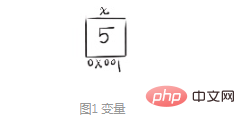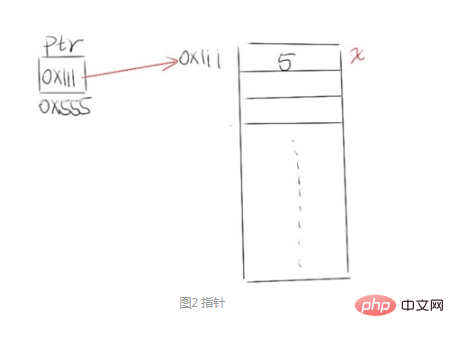 Backend Development
Backend Development
 C#.Net Tutorial
C#.Net Tutorial
 What is the difference between a reference and a pointer in C++?
What is the difference between a reference and a pointer in C++?
What is the difference between a reference and a pointer in C++?
Difference: 1. The pointer has its own space, and the reference is just an alias; 2. The pointer can point to other objects during use, but the reference can only be a reference to an object and cannot be changed; 3. Pointers can have multiple levels of pointers (eg **p), while references are at one level; 4. The " " operator used by pointers and references has different meanings.

Related recommendations: C Video Tutorial
1. Variable
The first and most important thing is the definition of variable. When you declare a variable, the computer will bind the specified memory space to the variable name; this definition is very simple, but it is actually very abstract, for example : int x = 5; This is the simplest variable assignment statement. Assigning 5 to a memory space named x is essentially assigning the value 5 to a memory space named x.

The operation of variables in memory actually requires two steps:
Find out the value corresponding to the variable name memory address.
According to the found address, take out the value in the memory space corresponding to the address and perform operations.
2. Pointers
The special thing about pointers is that the value stored in the memory space corresponding to the pointer variable happens to be a certain memory address. . This is also one of the characteristics that distinguishes pointer variables from other variables. For example, a pointer is defined as follows:
int x = 5; int *ptr = &x;
ptr is a correction variable name. Obtaining the value in the memory pointed to by this pointer through a pointer is called dereferencing. Null pointers cannot be dereferenced.
The representation of pointer memory space is as follows:

#3. Reference
Reference (reference) in C It is also often used, especially when used as a function parameter and when the value outside the function needs to be modified and updated inside the function. First of all, we must make it clear that a reference is a special kind of pointer.
A reference is a constant pointer pointing to another object, which holds the storage address of the pointed object. And it will be automatically dereferenced when used, without the need to explicitly retrieve it like using a pointer.
For example, the definition of reference is as follows:
int x = 5; int &y = x;
4. Summary of the difference between pointers and references
Pointers have their own piece space, and the reference is just an alias;
Use sizeof to see that the size of a pointer is 4, while the reference is the size of the referenced object;
The pointer can be initialized to NULL, but the reference must be initialized and must be a reference to an existing object;
When passed as a parameter, the pointer needs to be dereferenced before the object can be referenced Perform operations, and direct modifications to the reference will change the object pointed to by the reference;
The pointer can point to other objects during use, but the reference can only be a reference to an object and cannot be Change;
Pointers can have multiple levels of pointers (**p), while references are at one level;
Pointers and references use operators The meanings are different;
If you return an object or memory allocated by dynamic memory, you must use a pointer, and the reference may cause a memory leak.
For more programming-related knowledge, please visit: Introduction to Programming! !
The above is the detailed content of What is the difference between a reference and a pointer in C++?. For more information, please follow other related articles on the PHP Chinese website!

Hot AI Tools

Undresser.AI Undress
AI-powered app for creating realistic nude photos

AI Clothes Remover
Online AI tool for removing clothes from photos.

Undress AI Tool
Undress images for free

Clothoff.io
AI clothes remover

AI Hentai Generator
Generate AI Hentai for free.

Hot Article

Hot Tools

Notepad++7.3.1
Easy-to-use and free code editor

SublimeText3 Chinese version
Chinese version, very easy to use

Zend Studio 13.0.1
Powerful PHP integrated development environment

Dreamweaver CS6
Visual web development tools

SublimeText3 Mac version
God-level code editing software (SublimeText3)

Hot Topics
 1378
1378
 52
52
 How to implement the Strategy Design Pattern in C++?
Jun 06, 2024 pm 04:16 PM
How to implement the Strategy Design Pattern in C++?
Jun 06, 2024 pm 04:16 PM
The steps to implement the strategy pattern in C++ are as follows: define the strategy interface and declare the methods that need to be executed. Create specific strategy classes, implement the interface respectively and provide different algorithms. Use a context class to hold a reference to a concrete strategy class and perform operations through it.
 What is the role of char in C strings
Apr 03, 2025 pm 03:15 PM
What is the role of char in C strings
Apr 03, 2025 pm 03:15 PM
In C, the char type is used in strings: 1. Store a single character; 2. Use an array to represent a string and end with a null terminator; 3. Operate through a string operation function; 4. Read or output a string from the keyboard.
 Why does an error occur when installing an extension using PECL in a Docker environment? How to solve it?
Apr 01, 2025 pm 03:06 PM
Why does an error occur when installing an extension using PECL in a Docker environment? How to solve it?
Apr 01, 2025 pm 03:06 PM
Causes and solutions for errors when using PECL to install extensions in Docker environment When using Docker environment, we often encounter some headaches...
 How to calculate c-subscript 3 subscript 5 c-subscript 3 subscript 5 algorithm tutorial
Apr 03, 2025 pm 10:33 PM
How to calculate c-subscript 3 subscript 5 c-subscript 3 subscript 5 algorithm tutorial
Apr 03, 2025 pm 10:33 PM
The calculation of C35 is essentially combinatorial mathematics, representing the number of combinations selected from 3 of 5 elements. The calculation formula is C53 = 5! / (3! * 2!), which can be directly calculated by loops to improve efficiency and avoid overflow. In addition, understanding the nature of combinations and mastering efficient calculation methods is crucial to solving many problems in the fields of probability statistics, cryptography, algorithm design, etc.
 Four ways to implement multithreading in C language
Apr 03, 2025 pm 03:00 PM
Four ways to implement multithreading in C language
Apr 03, 2025 pm 03:00 PM
Multithreading in the language can greatly improve program efficiency. There are four main ways to implement multithreading in C language: Create independent processes: Create multiple independently running processes, each process has its own memory space. Pseudo-multithreading: Create multiple execution streams in a process that share the same memory space and execute alternately. Multi-threaded library: Use multi-threaded libraries such as pthreads to create and manage threads, providing rich thread operation functions. Coroutine: A lightweight multi-threaded implementation that divides tasks into small subtasks and executes them in turn.
 distinct function usage distance function c usage tutorial
Apr 03, 2025 pm 10:27 PM
distinct function usage distance function c usage tutorial
Apr 03, 2025 pm 10:27 PM
std::unique removes adjacent duplicate elements in the container and moves them to the end, returning an iterator pointing to the first duplicate element. std::distance calculates the distance between two iterators, that is, the number of elements they point to. These two functions are useful for optimizing code and improving efficiency, but there are also some pitfalls to be paid attention to, such as: std::unique only deals with adjacent duplicate elements. std::distance is less efficient when dealing with non-random access iterators. By mastering these features and best practices, you can fully utilize the power of these two functions.
 Usage of releasesemaphore in C
Apr 04, 2025 am 07:54 AM
Usage of releasesemaphore in C
Apr 04, 2025 am 07:54 AM
The release_semaphore function in C is used to release the obtained semaphore so that other threads or processes can access shared resources. It increases the semaphore count by 1, allowing the blocking thread to continue execution.
 How to apply snake nomenclature in C language?
Apr 03, 2025 pm 01:03 PM
How to apply snake nomenclature in C language?
Apr 03, 2025 pm 01:03 PM
In C language, snake nomenclature is a coding style convention, which uses underscores to connect multiple words to form variable names or function names to enhance readability. Although it won't affect compilation and operation, lengthy naming, IDE support issues, and historical baggage need to be considered.



